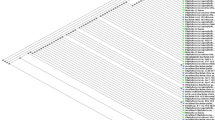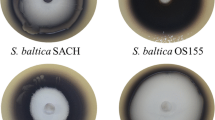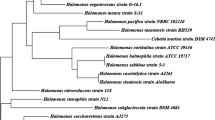Abstract
Oxyanions of tellurium, like tellurate (TeO4 2−) and tellurite (TeO3 2−), are highly toxic for most microorganisms. There are a few reports on the bacterial tellurite resistance mechanism(s). Salinicoccus iranensis, a Gram-positive halophilic bacterium, shows high tellurite resistance and NADH-dependent tellurite reduction activity in vitro. Since little is known regarding TeO3 2− resistance mechanisms in halophilic microorganisms, here one of the enzymatic reduction activities presented in this microorganism is investigated. To enhance the enzymatic activity during purification, the effect of different parameters including time, inoculation, different pHs, different tellurite concentrations and different salts were optimized. We also examined the tellurite removal rates by diethyldithiocarbamate (DDTC) during optimization. In the culture medium the optimum conditions obtained showed that at 30 h, 2 % inoculum, pH 7.5, without tellurite and with 5 % NaCl (w/v) the highest enzyme activity and tellurite removal were observed. Results of the purification procedure done by hydroxyapatite batch-mode, ammonium sulfate precipitation, followed by phenyl-Sepharose and Sephadex G-100 column chromatography, showed that the enzyme consisted of three subunits with molecular masses of 135, 63 and 57 kDa. In addition to tellurite reduction activity, the enzyme was able to reduce nitrate too. Our study extends the knowledge regarding this process in halophilic microorganisms. Besides, this approach may suggest an application for the organism or the enzyme itself to be used for bioremediation of polluted areas with different contaminants due to its nitrate reductase activity.





Similar content being viewed by others
References
Amoozegar MA, Hamedi J, Dadashipour M, Shariatpanahi S (2005) Effect of salinity on the tolerance to toxic metals and oxyanions in native moderately halophilic spore-forming bacilli. World J Microbiol Biotechnol 21:1237–1243
Amoozegar MA, Schumann P, Hajighasemi M, Ashengroph M, Razavi MR (2008a) Salinicoccus iranensis sp. nov., a novel moderate halophile. Int J Syst Evol Microbiol 58:178–183
Amoozegar MA, Ashengroph M, Malekzadeh F, Reza Razavi M, Naddaf S, Kabiri M (2008b) Isolation and initial characterization of the tellurite reducing moderately halophilic bacterium, Salinicoccus sp. strain QW6. Microbiol Res 163:456–465
Amoozegar MA, Khoshnoodi M, Didari M, Hamedi J, Ventosa A, Baldwin SA (2012) Tellurite removal by a tellurium-tolerant halophilic bacterial strain, Thermoactinomyces sp. QS-2006. Ann Microbiol 62:1031–1037
Avazeri C, Turner RJ, Pommier J, Weiner JH, Giordano G, Verméglio A (1997) Tellurite reductase activity of nitrate reductase is responsible for the basal resistance of Escherichia coli to tellurite. Microbiology 143:1181–1189
Baesman SM, Bullen TD, Dewald J, Zhang D, Curran S, Islam FS, Beveridge TJ, Oremland RS (2007) Formation of tellurium nanocrystals during anaerobic growth of bacteria that use Te oxyanions as respiratory electron acceptors. Appl Environ Microbiol 73:2135–2143
Baesman SM, Stolz JF, Kulp TR, Oremland RS (2009) Enrichment and isolation of Bacillus beveridgei sp. nov., a facultative anaerobic haloalkaliphile from Mono Lake, California, that respires oxyanions of tellurium, selenium, and arsenic. Extremophiles 13:695–705
Barbier GG, Campbell WH (2005) Viscosity effects on eukaryotic nitrate reductase activity. J Biol Chem 280:26049–26054
Borghese R, Borsetti F, Foladori P, Ziglio G, Zannoni D (2004) Effects of the metalloid oxyanion tellurite (TeO3 2−) on growth characteristics of the phototrophic bacterium Rhodobacter capsulatus. Appl Environ Microbiol 70:6595–6602
Bradford M (1976) A rapid and sensitive method for the quantitation of microgram quantities of protein utilizing the principle of protein–dye binding. Anal Biochem 72:248–254
Chiong M, Gonzalez E, Barra R, Vasquez C (1988) Purification and biochemical characterization of tellurite reducing activities from Thermus thermophilus HB8. J Bacteriol 170:3269–3273
Etezad SM, Khajeh K, Soudi M, Ghazvini PTM, Dabirmanesh B (2009) Evidence on the presence of two distinct enzymes responsible for the reduction of selenate and tellurite in Bacillus sp. STG-83. Enzyme Microb Tech 45:1–6
Filimonenkov AA, Zvyagilskaya RA, Tikhonova TV, Popov VO (2010) Isolation and characterization of nitrate reductase from the halophilic sulfur-oxidizing bacterium Thioalkalivibrio nitratireducens. Biochemistry (Mosc) 75:744–751
Fthenakis VM, Kim HC, Alsema E (2008) Emissions from photovoltaic life cycles. Environ SciTechnol 42:2168–2174
Kabiri M, Amoozegar MA, Tabebordbar M, Gilany K, Salekdeh GH (2009) Effects of selenite and tellurite on growth, physiology, and proteome of a moderately halophilic bacterium. J Proteome Res 8:3098–3108
Kinkle BK, Sadowsky MJ, Johnstone K, Koskinen WC (1994) Tellurium and selenium resistance in Rhizobia and its potential use for direct isolation of Rhizobium meliloti from soil. Appl Environ Microbiol 60:1674–1677
Klonowska A, Heulin T, vermeglio A (2005) Selenite and tellurite reduction by Shewanella oneidensis. Appl Environ Microbiol 71:5607–5609
Laemmli UK (1970) Cleavage of structural proteins during the assembly of the head of bacteriophage T4. Nature 227:680–685
Lefebvre O, Moletta R (2006) Treatment of organic pollution in industrial saline wastewater: a literature review. Water Res 40:3671–3682
Lund K, DeMossJ A (1976) Association–dissociation behavior and subunit structure of heat-released nitrate reductase from Escherichia coli. J Biol Chem 251:2207–2216
Moreno-Vivián C, Cabello P, Manuel Marti´nez-Luque M, Blasco R, Castillo F (1999) Prokaryotic nitrate reduction: molecular properties and functional distinction among bacterial nitrate reductases. J Bacteriol 181:6573–6584
Moscoso H, Saavedra C, Loyola C, Pichuantes S, Vasquez C (1998) Biochemical characterization of tellurite-reducing activities of Bacillus stearothermopilus V. Res microbial 149:389–397
Pérez JM, Caldeŕon IL, Arenas FA, Fuentes DE, Pradenas GA, Fuentes EL, Sandoval JM, Castro ME, Eĺıas AO, V´asquez CC (2007) Bacterial toxicity of potassium tellurite: unveiling an ancient enigma. PLoS One 2:e211
Sabaty M, Avazeri C, Pignol D, Vermeglio A (2001) Characterization of the reduction of selenate and tellurite by nitrate reductase. Appl Environ Microbiol 67:5122–5126
Terai T, Kamahora T, Yamamura Y (1958) Tellurite reductase from Mycobacterium avium. J Bacteriol 75:535–539
Theisen J, Zylstra GJ, Yee N (2013) Genetic evidence for a molybdopterin-containing tellurate reductase. Appl Environ Microbiol 79:3171–3175
Tremaroli V, Fedi S, Zannoni D (2007) Evidence for a tellurite-dependent generation of reactive oxygen species and absence of a tellurite-mediated adaptive response to oxidative stress in cells of Pseudomonas pseudoalcaligenes KF707. Arch Microbiol 187:127–135
Turner RJ, Weiner JH, Taylor DE (1992) Use of diethylditiocarbamate for quantitative determination of tellurite uptake by bacteria. Anal Biochem 204:292–295
Turner RJ, Pommie J, Weiner JH, Giordano G, Vermeglio A (1997) Tellurite reductase activity of nitrate reductase is responsible for the basal resistance of Escherichia coli to tellurite. Microbiology 143:1181–1189
Wilson CM (1983) Staining of proteins on gels: comparison of dyes and procedures. Methods Enzymol 91:236–247
Yurkov VV, Thomas BJ (1998) Aerobic anoxygenic phototrophic bacteria. Microbiol MolBiol Rev 62:695–724
Zannoni D, Borsetti F, Harrison JJ, Turner RJ (2007) The bacterial response to the chalcogen metalloids Se and Te. Adv Microb Physiol 53:1–71
Zhuang X, Han Z, Bai Z, Zhuang G, Shim H (2010) Progress in decontamination by halophilic microorganisms in saline wastewater and soil. Environ Pollut 158:1119–1126
Acknowledgments
The authors would like to express their gratitude to the research council of University of Tehran and Tarbiat Modares University.
Author information
Authors and Affiliations
Corresponding authors
Additional information
Communicated by A. Oren.
Rights and permissions
About this article
Cite this article
Alavi, S., Amoozegar, M.A. & Khajeh, K. Enzyme(s) responsible for tellurite reducing activity in a moderately halophilic bacterium, Salinicoccus iranensis strain QW6. Extremophiles 18, 953–961 (2014). https://doi.org/10.1007/s00792-014-0665-6
Received:
Accepted:
Published:
Issue Date:
DOI: https://doi.org/10.1007/s00792-014-0665-6




